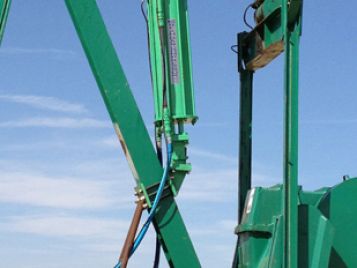Beam Gas Compressors
BGC are used to suck off casing gas and further compress this gas into the flow line. Due to the reduced casing pressure the inflow performance of the liquid is increased. BGC are suitable to be installed on all types of beam pumping unit and are designed as reciprocating compressors where the cylinder is able to handle operating pressures up to 28 bar (depending on the cylinder diameter). The cylinder is made of fiber glass and the internal surface is coated with “Microfinish”.
BGC can be either single acting or double acting, compressing and sucking in either direction, where the kinetic energy of the pumping unit is used to drive the compressor.
Advantage:
Depending on formation and well condition you might:
- increase oil production due to reduced casing pressure
- increase gas production
- use kinetic energy from up-/down stroke of the pumping unit to drive the BGC.
Function of a double acting bgc:
During the upstroke of the piston rod, gas is sucked through the suction valve into lower part of the cylinder. At the same time gas within the upper compartment is compressed and discharged into the flow line through the discharge valve. During the down stroke of the piston rod, the whole process works vice versa.
Temperature monitoring – ATEX DIRECTIVE 94/9/EG
According to the ATEX Directive 94/9/EG measurements have to be taken to prevent activation of any potential source of ignition.
Consequentially the temperature in the stuffing box is monitored as well as the temperature in the compression chamber(s), as compressed gas tends to heat up.
Monitoring is done by PT100 temperature elements. The registered signals are transferred to temperature transducers.
Further all national standards and codes for the installation and operation of plants within hazardous area have to be checked.
(e.g. ÖVE/ÖNORM E 8065 for Austria)
Standards/Code
The BGC complies with:
- Maschinensicherheitsverordnung MSV: BGB1.306/1994
- EC-Richtlinie Maschinen 98/37/EG in der geltenden Fassung
- EN 292, EN 294, EN 349, EN 418, EN 811, EN 954-, EN 60204-1
- EN13463 Teil 1, EN13463 Teil 5, EN13463 Teil 6
Further applied EC-directives:
- EMV directive 89/336/EWG
- ATEX directive 94/9/EG
